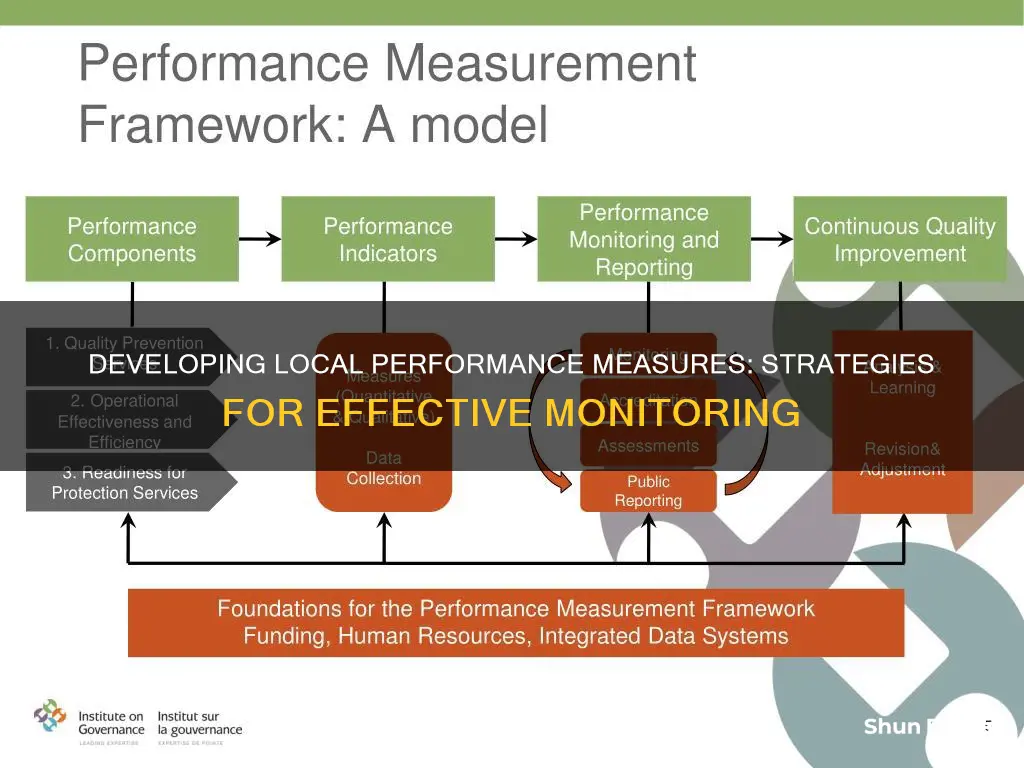
Performance measurement is a crucial aspect of organisational growth and improvement. It involves the systematic collection, analysis and evaluation of data to assess a project's efficiency and effectiveness in achieving its desired outcomes, goals and objectives. While performance measurement is typically undertaken by organisations to demonstrate accountability, support decision-making and improve processes, it is not a one-size-fits-all approach. Each organisation must develop its own performance measures based on its unique context and objectives. This process should be integrated into the initial planning stages of any project with clear goals and objectives. Performance measurement frameworks offer flexibility, allowing organisations to monitor the effectiveness of a pilot project, a multi-year programme or a strategic planning process for new or existing initiatives.
Performance management, on the other hand, involves using performance measurement data to inform actions that improve outcomes. This is particularly relevant for local authorities, where effective performance management ensures that local service providers are held accountable for their performance and that public money is spent wisely.
To develop and monitor local performance measures effectively, it is essential to follow a structured process. This includes preparing for performance measures, identifying outcomes using a logic model, creating performance measures, and collecting, analysing and communicating the results.
| Characteristics | Values |
|---|---|
| Purpose | To improve outcomes for residents and increase productivity, sales and revenue |
| Who | Management, staff members and stakeholders |
| What | Data points to evaluate progress |
| How | Set clear organisational goals, collect and share data, incentivise employees |
| When | Regularly and throughout the year |
| Where | Local government, businesses, agriculture, agri-food and economic development organisations |
What You'll Learn

Identify desired outcomes using a logic model
A logic model is a program planning tool that defines the inputs, outputs, and outcomes of a program to explain the thinking behind its design and show how specific activities lead to desired results. It is a visual tool that helps to outline the intended activities and results of a program, clarifying program goals and objectives.
Developing a logic model involves the following steps:
Step 1: Identify the Problem
Firstly, the problem being addressed by the program needs to be well-defined so that all stakeholders have a shared understanding. This problem statement should also include a description of who is most affected by the issue.
Step 2: Determine Key Program Inputs
Next, identify the resources needed for a successful program, such as human resources, office supplies, and field resources. It is helpful to create two columns: one listing the essentials and another outlining "wish list" items that are desirable but not critical.
Step 3: Determine Key Program Outputs
Outputs refer to the activities, services, events, and products that will reach the program's primary audience. To identify these, consider creating a list of actions that will be taken to achieve program objectives. Review the inputs list to ensure it includes the resources needed for each output.
Step 4: Identify Program Outcomes
Determine the short-term, mid-term, and long-term goals or outcomes of the program. These outcomes should closely align with the solution to the problem identified in Step 1 and should be achievable through the defined inputs and outputs.
Step 5: Create a Logic Model Outline
Once the inputs, outputs, and outcomes have been defined, they can be organized into a logic model outline. This outline should include:
- Short-, mid-, and long-term goals
- Resources needed for program success
- Actions to be taken by program staff
- The population that needs to be engaged
- The problem the program aims to address and its ultimate goal
Step 6: Identify External Influencing Factors
It is important to consider external factors that may impact the program's success. These could include the setting or environment in which the program will operate, the presence of other organizations or programs in the same area, and any influences or relationships that need to be established to achieve the desired impact.
Step 7: Identify Program Indicators
While developing more detailed program indicators is beyond the scope of this guide, it is important to start thinking about them. These indicators will help track progress toward outputs and outcomes. For example, how many training workshops will be held in the next six months? How many volunteers will be recruited?
By following these steps, you can effectively identify desired outcomes using a logic model, providing a clear direction for your program or initiative.
Esophageal pH Monitoring: Procedure and Performance Insights
You may want to see also

Develop performance measures
Developing and monitoring local performance measures is crucial for growth and improvement. Performance measures are data points that teams can use to evaluate their progress. They are also referred to as performance metrics or performance indicators.
Performance measurement is typically done by an organization to demonstrate accountability, support decision-making, and improve processes. It is a systematic approach to collecting, analyzing, and evaluating how “on track” a project or program is in achieving its desired outcomes, goals, and objectives.
Stage I: Prepare for Performance Measures
This stage involves setting the foundation for implementing a performance measurement framework. It includes establishing a team, identifying and engaging stakeholders, and clarifying the organization's current position and desired goals.
Stage II: Identify Outcomes using a Logic Model
In this stage, the desired outcomes and the problem that needs to be addressed are identified. A logic model, which is a visual representation of the connections and relationships between inputs, outputs, and outcomes, is introduced as a roadmap for the strategy.
Stage III: Create Performance Measures
This stage focuses on the types of performance measures that can be used and their importance in the logic model. It includes a four-step process to create performance measures: brainstorming, assessment, shortlisting, and documentation.
Involving Staff Members in Creating Personal Goals
Involving employees in setting personal performance measures fosters a dynamic and goal-oriented work environment. It empowers staff to take ownership of their evaluation criteria, increasing transparency, productivity, and performance.
Stage IV: Collect, Analyze, and Communicate the Results
This final stage involves determining effective ways to collect and analyze data, reporting and communicating results, and using the information to improve strategies and initiatives.
By following these steps, organizations can develop comprehensive performance measures that align with their goals and objectives, enabling them to track progress, make informed decisions, and drive improvement.
Identifying Your ASUS Monitor: A Step-by-Step Guide
You may want to see also

Collect, analyse and communicate results
Performance measurement is a systematic approach to collecting, analysing and evaluating how “on track” a project/program is to achieve its desired outcomes, goals and objectives. Performance measurement is typically done to demonstrate accountability, support decision-making and improve processes.
Performance measures provide information to assist in making strategic decisions about what an organisation does and how it performs. Performance measurement frameworks are flexible and can be used to measure the effectiveness of a pilot project, a multi-year programme or a strategic planning process, and can be applied to a new or existing initiative.
Performance measurement should be treated as an integral part of any planning process from the outset and should be built into any plan or project that has clear goals and objectives. It is not an approach that prescribes what must be measured; organisations need to develop their own performance measures based on their project plans and situations.
A successful performance measurement framework requires the organisation to focus on relevant goals/outcomes and on using good-quality data for its measures.
There are three parts to this stage:
- Determining effective ways to collect and analyse data
- How to report and communicate results
- How to use the information gathered to improve a strategy/initiative
A well-developed performance measurement framework allows the telling of a convincing story, using credible evidence about the outcomes of a project. The framework should align with these three elements:
- What does your organisation want to achieve, where does it want to make a difference, and what are the desired outcomes?
- What steps does your organisation need to take to achieve its objectives?
- How will your organisation know that its plan is on track to achieve its objectives and reach its desired outcomes?
The narrative created needs to be compelling, easy to understand and backed up using solid evidence and plausible assumptions from the performance measures created. If this is achieved, the plan will be defensible, and others will be convinced that it is a good investment.
Performance measurement is the longest phase in the performance management cycle. During this phase, the manager/evaluator is supposed to keep an eye on the performance related to the set targets and constantly monitor it to be able to keep it on the right track. The purpose of this phase is not only to measure and evaluate the end results but to control the overall performance throughout the whole period between target setting and evaluation.
Performance measurement starts with target setting. When setting the goals and the specific targets (KPIs) for each goal, it is important to foresee how the achievement of the target will be monitored and measured. If a certain target cannot be measured, or is very difficult to measure, then such a target shouldn't be set.
The next step in the monitoring and measurement process would be to define a monitoring and measurement plan. This should comprise:
- Defining Key Performance Indicators (KPIs)
- Defining Tools and Methods for Monitoring, Measuring and Evaluation
- Defining Activities Plan
- Defining Resources
- Assigning people to perform the measurement and monitoring
Adjusting Extended Monitor Size: A Simple Guide to Downsizing
You may want to see also

Use data to inform actions
Using data to inform actions is a critical aspect of performance management for local authorities. It involves collecting, analysing, and evaluating data to assess the efficiency and effectiveness of projects, programs, and initiatives. This process is designed to support the company's strategy and the achievement of its goals.
When it comes to using data to inform actions, there are several key steps to consider:
Collect Relevant Data:
Identify the key performance indicators (KPIs) that align with the organisation's goals and objectives. Examples of KPIs include revenue, market share, customer satisfaction, and employee productivity. Collect data from various sources such as surveys, reports, sales records, and customer reviews. Ensure that the data is reliable, accurate, and relevant to the specific goals being measured.
Analyse and Interpret Data:
Analyse the collected data to identify trends, patterns, and areas for improvement. Compare the current performance with the desired targets and goals. Interpret the data to gain insights into what is working well and what needs to be improved.
Make Data-Informed Decisions:
Use the analysed data to make informed decisions about strategic actions. For example, if the data shows that customer satisfaction has decreased, decisions can be made to improve customer service strategies. Data can also guide resource allocation, budgeting, and process improvements.
Monitor and Evaluate:
Implement monitoring systems to track the impact of the actions taken. Continuously collect data and evaluate whether the actions are leading to the desired outcomes. This step ensures that the organisation remains on track and can make any necessary adjustments to its strategies.
Adjust and Improve:
Based on the evaluation of the data, make adjustments to strategies, processes, or targets as needed. This step ensures that the organisation can adapt and improve its performance over time. It also allows for course corrections if the data indicates that the current strategies are not effective.
By following these steps, local authorities can use data to inform their actions, improve their decision-making, and ultimately enhance their performance and achieve their desired goals. It is important to remember that data collection and analysis should be ongoing and integrated into the performance management process to ensure the organisation's strategies remain effective and aligned with its goals.
Is Your iPad Being Monitored? Here's How to Tell
You may want to see also

Set targets and make a monitoring and measurement plan
Setting targets and making a monitoring and measurement plan is a critical phase in the performance management cycle. This phase involves keeping a close eye on the performance related to the set targets and constantly monitoring it to ensure it stays on track. The purpose of this phase is not merely to evaluate the end results but to manage and control the overall performance throughout the period between target setting and evaluation. This is what gives true meaning to the performance management system, making it a tool for management rather than just evaluation.
Define Key Performance Indicators (KPIs)
KPIs are measurable, traceable, and visible indicators of the achievement or non-achievement of a goal. They are a crucial part of any performance management system as they provide the basis for monitoring and measurement. KPIs should be set at the beginning of the process, during target setting, so that employees can immediately start gathering relevant information. When setting KPIs, consider whether they are key contributors to the success of the goal and whether they can be measured, quantified, adjusted, and controlled. Examples of KPIs include revenue, income, market share, customer churn, and employee satisfaction.
Define Tools and Methods for Monitoring, Measuring, and Evaluation
After defining the KPIs, the next step is to determine the methods, measures, and tools for gathering the necessary information for analysis. This will depend on the nature of the goal and the KPI. Information can be collected from various sources such as activity reports, meeting notes, financial reports, surveys, and interviews.
Define an Activities Plan and Schedule
The frequency of information gathering and analysis will depend on the nature of the goal and the KPI. Some goals may require daily measuring and monitoring, while others may be evaluated on a monthly or quarterly basis.
Define Resources
Once the methods and tools have been defined and the activities plan has been set, the next step is to identify the resources needed to perform the monitoring and measurement. This includes allocating material, financial, and human resources. Assign specific individuals to carry out the measurement and monitoring tasks.
By following these steps, organisations can effectively set targets and create a comprehensive monitoring and measurement plan, ensuring that performance management is a continuous process that drives improvement and achieves strategic goals.
Simple Ways to Identify Your Monitor's 2K Resolution
You may want to see also
Frequently asked questions
Performance management measures are a set of proactive methods and practices that organisations can use to track production. They are data points that teams can use to evaluate their progress and help improve outcomes within a team.
Performance measurement tracks progress toward specific goals. For example, tracking the number of sales calls made in a day. Performance management, on the other hand, assesses, evaluates and directs strategies to reach those goals. It also helps predict how performance measures may affect the company in the future.
Performance measurement can help demonstrate accountability, support decision-making and improve processes. It can also help inform strategic decisions, adjust plans, and reset priorities. Regular performance measurement can drive results and enable an organisation to learn from its successes and failures.
The four key stages to developing a performance measurement framework are:
- Stage I: Prepare for Performance Measures
- Stage II: Identify Outcomes using a Logic Model
- Stage III: Create Performance Measures
- Stage IV: Collect, Analyze Data and Communicate the Results







